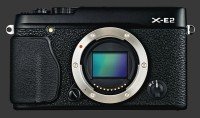Fujifilm X-E2 Review
Fujifilm X-E2 Performance - How well does it take pictures?
Performance starts with image quality, which is the criteria used as the foundation of our digital camera ratings. Ergonomic issues may get in the way, but in the end, image quality counts the most. For an ILC, image quality greatly depends on the lens used. While color, noise, exposure and dynamic-range are properties of a camera, distortion, vignetting and chromatic aberrations are properties of the lens. Sharpness and contrast depend on the weakest link. That is, a camera cannot capture more details than a lens lets through. Conversely, it is quite possible for a lens to transmit more details than a sensor can capture.
Image Noise & Details
The Fuji X-E2 produces images of exceptional quality, exceeding the quality of the almost all cropped-sensor DSLR throughout its range of ISO sensitivities, making it even comparable to some full-frame models. Image noise is inexistent all the way to ISO 1600 and becomes barely detectable at ISO 3200. ISO 6400 is almost the same and only at ISO 12800 do some details get affected by noise. Still, mid-size prints are possible at such high sensitivity..
The final expanded ISO of 25600 is unusable. Not only is it very noisy but there is also a bluish tint that gradually increases towards the bottom edge of the frame.

While we know the unique X-Trans sensor delivers in terms of sharpness from the X100S review, output was not so sharp with the X-E2 since the only lens available for testing was the Fuji zoom. Even so, fine-details get resolved by that lens, albeit with lower local contrast.
Sharpness is controllable in 5 levels. Things start from a very soft to over-sharp, so each step is quite coarse. The default level leaves a little softness and one above adds a touch of sharpness with minimal artifacts. The image-noise reduction is a little too aggressive which prevents the X-E2 from reaching its full potential. There are 5 levels of noise reduction and they extremely close in output quality.
Color & White Balance
Color accuracy of the X-E2 is very good. Hues realistic with different Film Simulation mode mostly affecting saturation. The standard Provia film exaggerates saturation which can be improved by setting Color to -1. Alternately, using Pro Negative Standard film simulation provides a similar rendition of color.
Automatic White-Balance is quite dependable under typical conditions. It handles both natural and artificial lighting surprisingly well, only leave the occasional yellow cast for incandescent and magenta for fluorescent. The twisted issue though is that AWB is often previewed incorrectly, tricking the user into incorrectly changing settings. The Custom White-Balance option is there for difficult situations and is perfectly accurate.

Exposure
The Multi-Segment metering system of the X-E2 is extremely reliable and consistent. It is highly conservative which results in darker-than-usual images. It rarely blows anything but the smallest highlights, although it may not seem like it on the EVF and LCD because their dynamic-range is much more narrow than what this camera can capture.
Dynamic-Range of the X-E2 is spectacular when increased to 200% starting at ISO 400 or to 400% starting at ISO 800 which is possible all the way to all the way to 6400. This camera handles high-contrast scenes even better than most digital cameras, including top-of-the-line DSLRs.

Auto Focus
The X-E2 features a hybrid Phase-Detect and Contrast-Detect AF system for the first time on a Fuji mirrorless. The camera exposes a 49-point AF system which uses both systems at each point to achieve class-leading autofocus speeds.
Autofocus has been visibly improved from the X-E1. The new system is faster and just as sensitive in low-light. It locks focus more decisively. Under good to moderate light, this Fuji locks focus in less than ½s. AF can take just a little longer in low-light yet it remains better than previous mirrorless generations.
Continuous AF (AF-C) is also much improved. Unlike the Contrast-Detect system of its predecessor, the new hybrid AF finds focus without any back-and-forth motion. It transitions extremely smoothly and quietly between subjects which is great for video but too slow for keeping up with action.
Spot-Focus, sometimes called AF-On by other brands, lets the X-E2 autofocus on-demand while in MF mode. Simply press the AF-L button and, around ½s later, focus will be locked nearly every time. Manual Focusing is done via a fly-by-wire ring at the front of current XF-mount lenses.
Speed
The Fuji X-E2 is quick and responsive. Nearly all actions occur without delay. It can shoot continuous at 7 FPS which is comparable to high-end DSLRs but notably slower than many of the latest mirrorless models from Olympus and Sony. The buffer is capable of absorbing 20 JPEG images or 12 RAW in one burst while using a fast memory card.
The following measurements characterize the performance of the Fuji X-E2:
- Power-On: About 1s without sensor-cleaning. Good.
- Power-On to First-Shot: 1½ seconds. Average.
- Autofocus: ¼ - ½s, depending on the light. Great.
- Shutter-lag: Immediate with under ½s blackout. Very good.
- Shot-to-shot: 1¼s even with AF. Average.
- Playback: About 3/4s to enter or exist. On the slow side.
- Power-Off: Under ½s with sensor-cleaning off. Great.
- Video: Nearly instant starting and stopping. Better than most.
The performance of the X-E2 is great yet somewhat uneven. Although entering and exiting Playback mode is slower than usual, only shot-to-shot speeds are disappointing. Autofocus and the crucial shutter-lag are great and go a long way to making this mirrorless camera very usable.

Having a true video mode makes the camera ready to start recording immediately and preview framing correctly. This is not so common among modern digital cameras, so despite Fuji not having emphasized video in the X-E2, it works perfectly. Focus in video can either by continuous or manual. As always, MF is highly recommended for video but, this time, only because the X-E2 may focus on the wrong subject. The back-and-forth movement of Contrast-Detect AF is gone.
The Fuji X-E2 is powered by a small proprietary Lithium-Ion battery which provides 350 shots-per-charge. This is about average and goes down quickly while reviewing images. Another battery is highly recommended not to run out unexpectedly. The small size of the battery makes it quite sensitive to cold and hardly be able to shoot even half its quoted maximum as temperatures approach freezing.
Fujifilm X-E2 Conclusion

The Fuji X-E2 is an impressive successor to the X-E1. The new 16 megapixels X-Trans CMOS II sensor delivers superb image-quality that is only slightly dulled by overly aggressive image-processing. This can be avoided by shooting RAW yet is not a solution for everyone. More importantly, the X-E2 notably improves usability compared to its predecessor while performing faster in key areas, including autofocus.
Image-quality of the Fuji X-E2 is near the very best mirrorless cameras, falling below only the older X-E1 and full-frame mirrorless cameras introduced this year. Image noise is virtually inexistent until ISO 3200 and only slowly progresses along with softness due to noise-reduction which starts appearing above ISO 800.
The output of this camera is highly usable for mid-size prints until ISO 12800 which is good yet one stop less than the X-E1. The most amazing aspect of the Fuji X-E2 is its incredible dynamic-range which, coupled with its excellent metering system, captures scenes of unusually high contrast.
Performance of the X-E2 is not perfect but quite solid. The hybrid Phase-Detect and Contrast-Detect AF system lives up to its promise and speeds of autofocus which brings the X-E2 up to modern mirrorless standards. Its shot-to-shot speed is not great but the 7 FPS continuous drive performs well while the EVF and LCD lag slightly behind the action.
Overall, the Fuji X-E2 is an excellent camera. It produces great-quality images in a relatively compact size with refined and highly usable ergonomics. The Fuji X-system has grown considerably since its launch with now 10 lenses from Fuji alone, plus some from third-party manufacturers. This makes it and other Fuji mirrorless ones suitable for most non-specialized types of photography. Despite a slight drop in image-quality, the faster speed can more-than-compensate for most users.
 |
Please Support Neocamera
All information on Neocamera is provided free of charge yet running this website is a huge endeavor. Purchases made via affiliate links found throughout the site help keep it running and up-to-date. There is no additional cost to you, so please consider buying via these links to our affilates:
If you found any information on this site valuable and did not purchase via our affiliate links, please considering donating via PayPal:
Any amount will be greatly appreaciated. Thank you for your support!
Fujifilm X-E2 Highlights

Sensor-Size: 24 x 16mm

Actual size when viewed at 100 DPI
| 16 Megapixels Mirrorless | ISO 100-25600 |
| Fujifilm X Mount 1.5X FLM | Shutter 1/4000-30s |
| 0.50" Built-in EVF 2.4 Megapixels (0.64X) | Full manual controls, including Manual Focus |
| Automatic Eye-Start sensor | Custom white-balance with 2 axis fine-tuning |
| 1 Axis Digital Level | Spot-Metering |
| Built-in Dust Reduction | Hot-Shoe |
| 7 FPS Drive, 20 Images | Stereo audio input |
| 1920x1080 @ 60 FPS Video Recording | Lithium-Ion Battery |
| 3" LCD 1 Megapixels | Secure Digital Extended Capacity |
Updates
2025.01.18

Fujifilm GFX 2025 Lens Roundup
Lens Review roundup of Fujifilm GFX Medium-Format lenses. Quality, performance and handling of the GF20-35mm F/4R WR, GF30mm F/3.5 Tilt-Shift and the GF55mm F/1.7.
2024.11.18

Best 2024 Photography Gifts for Every Budget
Great gifts for photographers and photo enthusiasts selected for every budget among the best products of 2024.
2024.08.07

Eye Protection Tips for Professional Photographers
The four main considerations for professional photographers regarding eyewear.
2024.07.14

Fujifilm X100VI Review
Flagship fixed-lens compact digital camera with a 40 MP sensor and Image-Stabilization, a first for the series. Retro design featuring dual control-dials, plus direct ISO, Shutter-Speed and EC dials. Its hybrid viewfinder can switch between EVF and OVF mode.
2024.05.09

Fujifilm GFX100 II Review
Flagship 102 Megapixels Medium-Format Mirrorless Digital Camera with 8-Stop 5-Axis IBIS, 8 FPS Drive, 8K Video and 400 MP Super-Resolution capture in a weatherproof and freezeproof body with dual control-dials and dual memory-card slots.
2024.04.03

Fujifilm X-T5 Review
Newest Fujifilm flagship boasting a 40 MP APS-C sensor, 5-axis IBIS with 7-stop efficiency, 15 FPS continuous drive, 6.2K Video capture, dual control-dials and dual SDXC UHS-II slots in a sturdy weatherproof and freezeproof body.
2023.11.20

Best Digital Cameras of 2023
Find out which are the Best Digital Cameras of 2023. All the new Mirrorless Digital Cameras from entry-level to high-end professional.
2023.07.10

Fujifilm X-H2 Review
40 Megapixels APS-C Hybrid Mirrorless Digital Camera with 7-stop IBIS. Fastest shutter ever and 8K video capture. Large builtin EVF with 0.8X magnification and 5.8 MP, plus an Eye-Start Sensor. Packed with features and large number of controls in a weatherproof and freezeproof body.
2023.05.07

Sony FE 20-70mm F/4G Review
Review of the unique Sony FE 20-70mm F/4G lens. The optical zoom of this lens spans ultra-wide-angle and medium focal-length coverage, making it one of the most versatile Full-Frame lenses on the market.
2023.01.15

Huion Inspiroy Dial 2 Review
Review of the Huion Inspiroy Dial 2 tablet, a medium sized drawing surface with dual dials and customizable buttons. Connects via USB-C or Bluetooth 5.0 with Windows, Linux and Android support.
2022.12.08

How to Pack for a Photo Trip
Find out how to pack for a travel photography trip, carry your gear safely while meeting airline regulations.
2022.11.13

Best Digital Cameras of 2022
The best digital cameras of 2022. A short list of the most outstanding models in their respective categories. Choose one for yourself or as a gift.












